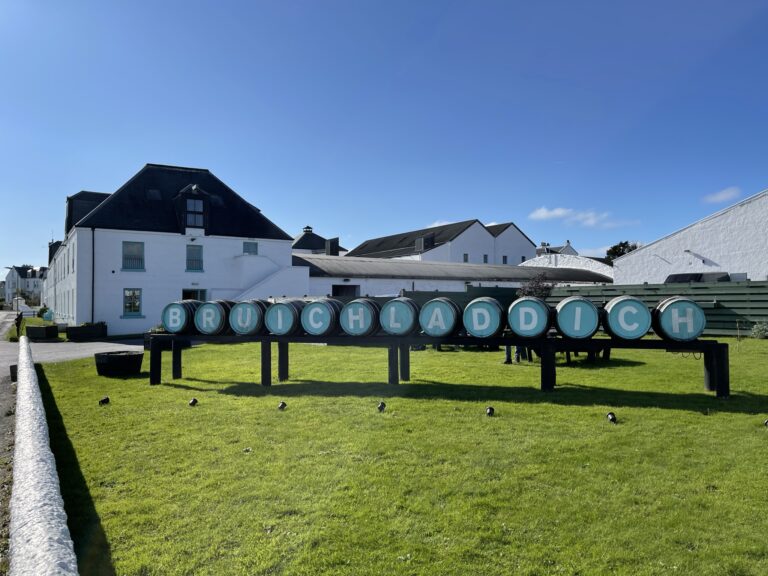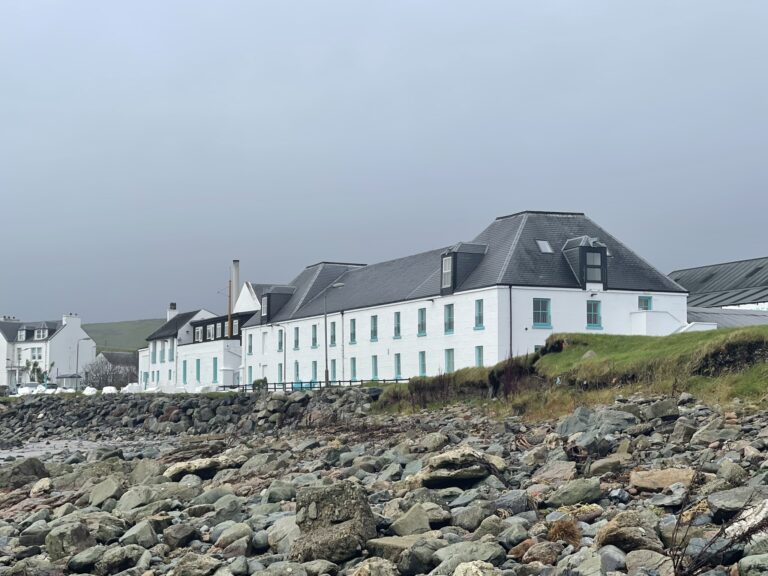Distillery Profiles:
Bruichladdich

Introduction
Bruichladdich Distillery stands on the Rhinns peninsula on the western side of the Isle of Islay. The name comes from the Gaelic Bruthach a’ Chladaich meaning “the slope of the shore”.
The distillery merges traditional production techniques with innovative production methods and contemporary marketing to create a world-renowned single malt brand. In 2012, the distillery was taken over by Remy Cointreau.
Bruichladdich produces a range of distinctive malts that have won the distillery a cult following. The Friends of Bruichladdich group on Facebook currently has more than 11,000 members.
Character
Bruichladdich’s whisky is somewhat atypical of Islay. The island is famed for its heavily peated, smoky whiskies but Bruichladdich is unpeated with a soft, floral and malty character.
The distillery also produces the Port Charlotte and Octomore single malts. Port Charlotte offers a more traditional Islay personality with barley peated to around 40ppm (phenol parts per million). Octomore goes a few steps further, with one batch topping out at 309ppm, making it the most heavily peated single malt in the world.
The team at Bruichladdich consolidate the distillery’s whisky output with a Scottish gin known as The Botanist. It’s made using 22 botanicals, many of which are hand-foraged around the island.
Place and Production
Bruichladdich was taken over by new ownership in 2001. Since then, a focus on terroir has been central to the ethos. Terroir is a French word which describes the impact of environmental factors on wine. It is the belief that everything from soil to microclimate and even farming practices can effect the flavour. If this principle can be applied to vineyards and wine, why not barley fields and whisky?
All of Bruichladdich’s barley is grown in Scotland with 40% coming from local farmers on Islay. Barley grown locally is used to distil spirit for the Islay Barley bottlings which declare the farm of origin on the label. Spirit has also been produced using organic, boidynamic and bere barley.
The distillery works with Bairds of Inverness Maltings. Even the barley harvested on Islay is shipped to the northeast for malting. There are, however, plans afoot to build a new malting floor at Bruichladdich, one that will be capable of dealing with all the locally grown barley.
Production water comes from the An Torran well but bottling water comes from the Octomore Spring. The water filters through layers of gneiss rock, formed more than 1.8 million years ago.
The distillery retains much of its Victorian equipment and relies on the skill and craft of its workforce. There is no automation in sight! Fermentation is long and the pot stills have tall, narrow necks. The result is a light, complex spirit unlike anything else on the island.
In recent years, Bruichladdich has demonstrated an increasing devotion to sustainability with various projects underway that will investigate a more responsible way of producing Scotch whisky. The utilisation of wave power is being considered and the distillery has been fitted with a new closed-loop hydrogen boiler. It has also led the way in terms of abandoning unnecessary and wasteful gift tubes.
History and Notable People
The Harvey Brothers
Bruichladdich was established in 1881 by three brothers: William, Robert and John Harvey. The brothers intended to produce an unpeated spirit, something made possible by the arrival of the Clyde Puffers, flat-bottomed boats that could easily transport coal from the mainland. The Puffers made it easier to avoid the reliance on peat that had, until then, shaped the style of the island’s whiskies.
The Harvey brothers owned two other distilleries in the city of Glasgow, Dundashill and Yoker, and planned to combine the three to create a blending and bottling empire. Robert was in charge of the design of the new distillery whilst William was responsible for the funding and John had the distilling knowledge that would help to craft the spirit. As tends to happen with families, however, there was a falling out before the construction could be completed. John parted ways with his brothers, leaving William and Robert to run a remote islay distillery with no distilling expertise between them. Somehow the brothers made a go of it but found themselves heavily reliant on selling their whisky to the big blending houses on the mainland, none of whom, had a huge desire to source unpeated whisky from Islay – not when they could fulfill their quotas much closer to home.
Robert Harvey passed away in 1892, leaving William in sole charge of Bruichladdich. The distillery struggled on, accumulating debt until things came to a head in 1907. William was forced to sell to Robertson & Baxter, who used the surviving stocks to clear the debts. The change in ownership marked the beginning of tumultuous times for the distillery and the decades that followed saw owners come and go with various periods of closure but somehow, Bruichladdich kept going. For a time, at least.
The Whisky Loch
Bruichladdich was taken over by Invergordon Distillers in 1968. The Scotch industry was enjoying something of a boom and single malts were beginning to appear on the market, some for the first time. Whilst the likes of Laphroaig was becoming a name in its own right, however, Bruichladdich continued to sell its spirit to blenders, totally reliant on the health of the wider market for its own survival.
Unsurprisingly, the good times of the 1960s and early 70s wouldn’t last. The next decade saw a shift in drinking habits with an increasing preference for white spirits like vodka leading to whisky being increasingly seen as an old man’s drink. The industry failed to heed the warning signs and carried on producing whisky on a massive scale. When the crash hit, it hit hard. The result was more whisky in warehouses than anyone knew what to do with. Unable to off-load the stocks they had, parent companies began mothballing distilleries and laying off staff. Production at Bruichladdich was intermittent at best, though it stumbled on until Invergordon was taken over by Whyte & MacKay in 1992. By then it had begun to fall into disrepair and the new owners decided to close it down. The future was beginning to look bleak.
One day as I was walking by the shore of Lochindaal,
I met a man with sadness in his eyes.
His story was as haunted as the lonely seabird’s call,
And he told me of the day, He wept and walked away,
As he watched the fire of Bruichladdich die.
– excerpt from Bruichladdich by Robin Laing
Jim McEwan
Several people played important roles in the rebirth of Bruichladdich but few are as recognised or as beloved as Jim McEwan. Born and raised in Bowmore, McEwan began his career as a cooper at the age of 15. He worked his way through several jobs at Bowmore Distillery before moving to Glasgow to learn the skills of the whisky blender. His return to the island saw him take up the mantle of Distillery Manager, often travelling the world to spread the word of Bowmore and Islay. McEwan wasn’t finished there, though. He had his eye on a new project. One that perched on the opposite bank of Loch Indaal. Waiting.
Bruichladdich was rescued from a sad end by Mark Reynier and Simon Coughlin, owners of the independent bottler, Murray McDavid. With the financial backing of several private investors, the two men were able to buy the distillery and any stocks that still lingered in its warehouses. In what would prove to be a real masterstroke, the pair approached Jim McEwan and offered him the role of Production Director.
McEwan developed a close working relationship with Distillery Manager Duncan McGillivray and the two set about the repair of the crumbling distillery. Through the hard work of the dedicated distillery team, Bruichladdich was soon creaking back to life and spirit began to flow from the old stills once again. McEwan’s expertise shaped the character and the quality of the new Bruichladdich and he was instrumental in the creation of the Port Charlotte, Octomore and Botanist brands.
In 2012, French family-owned drinks company, Remy Cointreau bought Bruichladdich but there was never any suggestion that the project would be led by anyone other than Mr McEwan. In fact, he remained at the helm for three more years, before finally deciding that it was time for the next chapter. McEwan retired from his role at Bruichladdich in 2015 but not before training his replacements in Allan Logan and Adam Hannett, thereby ensuring the distillery would remain in the safest of hands.

Curious Tales
Countless stories have come out of Bruichladdich over the years but in researching this piece we found one we hadn’t heard before. It’s a lovely little article from the Oban and Argyllshire Advertiser of Saturday 10th January 1914 which offers a tiny glimpse of island life a century ago and also highlights the place distilleries held at the heart of their local communities.
On the 29th December, the children in the district were invited by Miss Harvey, Bruichladdich Distillery, to a Christmas entertainment. The late arrival of the presents, due to the storms prevailing, prevented the treat being held on Christmas Day, but nevertheless about 30 happy children enjoyed the kindness of Miss Harvey.
A Christmas tree was well furnished with attractive gifts, of which each child got one, and a magic lantern gave great delight, as well as the gramophone of Miss Mitchell. All sat down to a tea-table supplied with all sorts of good things, and several hours were spent by the young people in great enjoyment.



